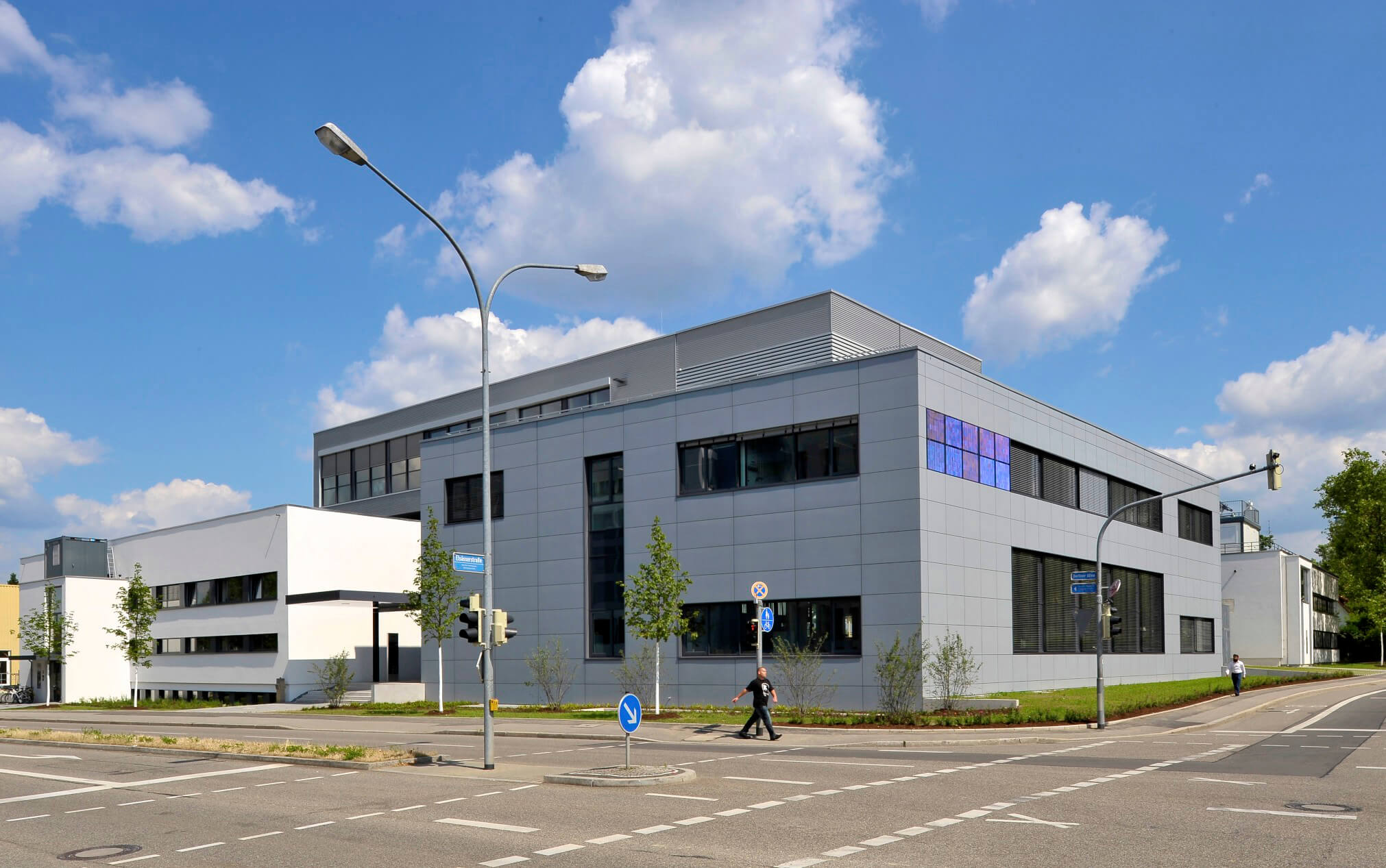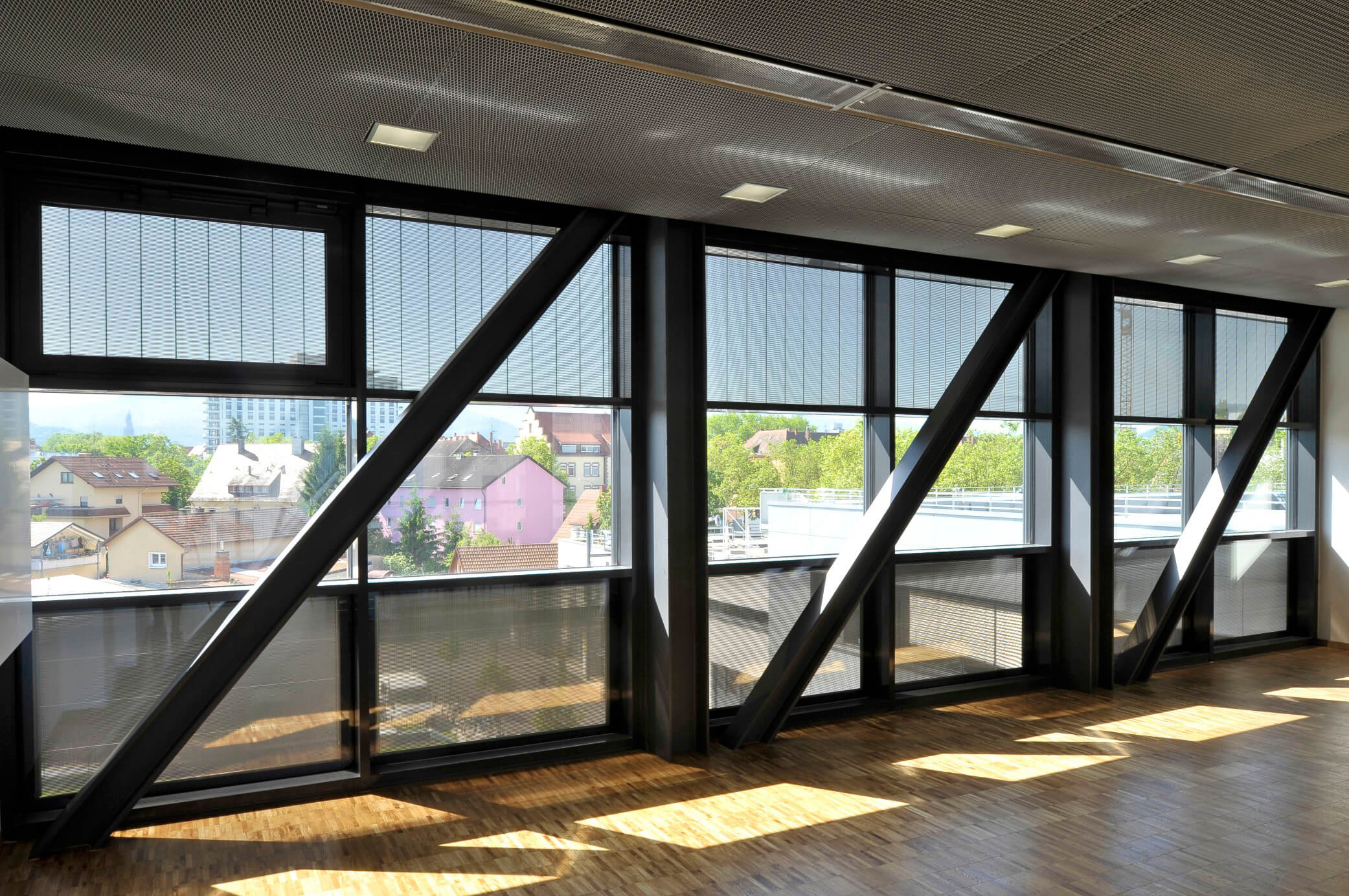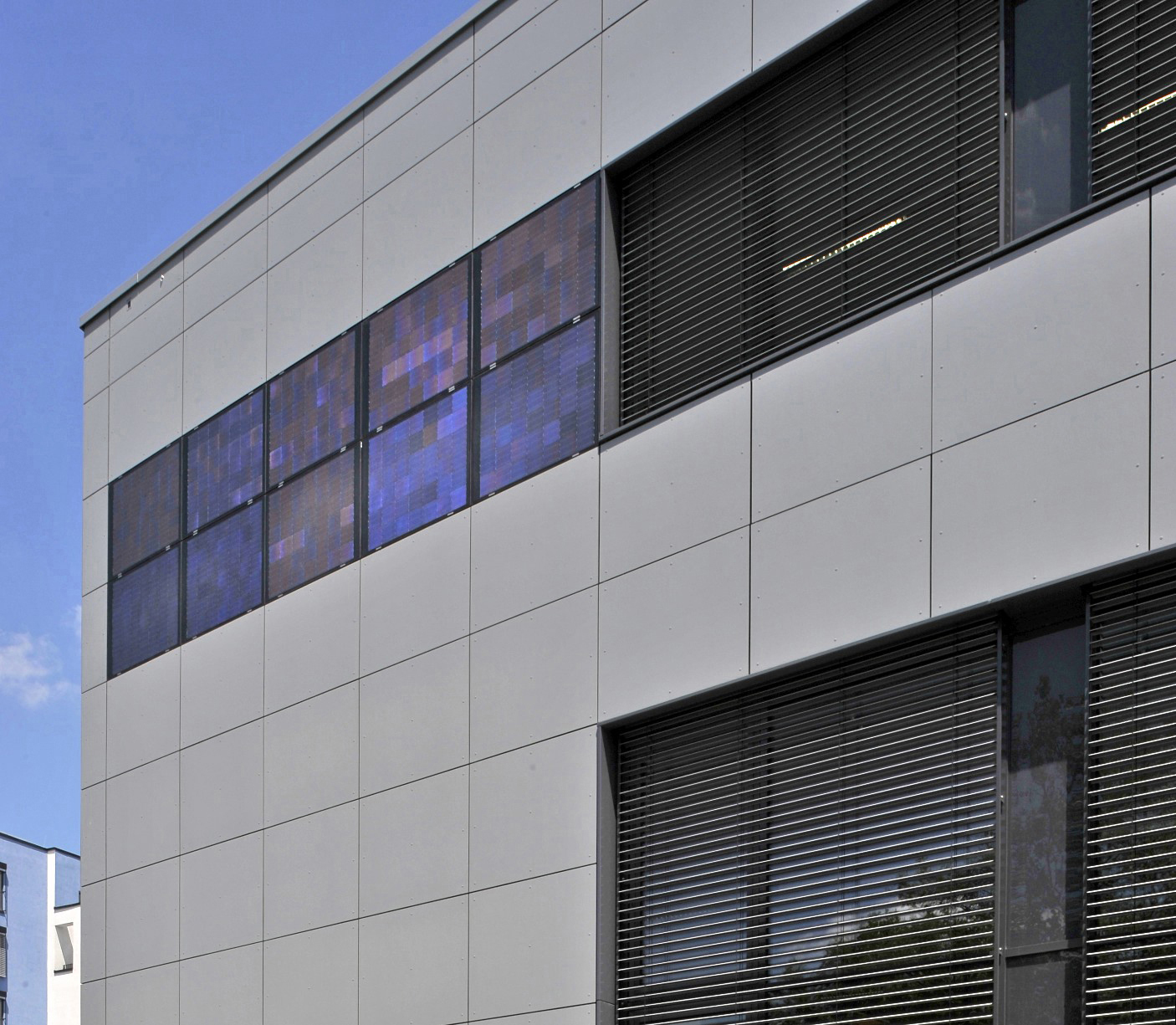Presseinformation #17
Fraunhofer ISE inaugurates new energy efficient laboratory building – Across-the-board competence for solar thermal and photovoltaics under one roof
On July 4, 2013 Fraunhofer ISE officially opened its new laboratory building in Freiburg, Germany in the presence of of the Science Minister of Baden-Württemberg, Theresia Bauer and other representatives from politics, finance and research. In the laboratories covering an area of 2400 m², scientists work on coatings, microstructures and optical and photonic applications for the generation of heat and electricity from solar energy. The researchers at Fraunhofer ISE developed the energy efficient building concept and realized it together with a team of planners, architects and industry partners. Strategies included the heating and cooling concepts through to the building-integrated photovoltaics.



“In many respects the new laboratory building represents a milestone for us,” says the Institute Director Prof. Eicke R. Weber. “With this laboratory facility, we are strengthening our cross-disciplinary expertise in the fields of solar thermal and photovoltaics. The building concept meets the highest expectations for energy efficiency and integrates the newest research results into the building.” About 30 project partners were involved in the realization, which lasted a period of two and a half years. The costs, amounting to 10.2 million euros, were covered 50% by the federal government (German Federal Ministry of Education and Research BMBF) and 50% by the State of Baden-Württemberg (Ministry of Finance and Economics Baden-Württemberg). “The support of the new laboratory building shows our clear commitment to investments in research and development for the transformation of our energy system. We can tackle this task only with a combination of all technologies. Networking between different research disciplines, like we find here at Fraunhofer ISE, is therefore absolutely essential,” says Baden-Württemberg’s Science Minister Theresia Bauer.
Research Laboratories for Solar Thermal and PV
In 2001 as Fraunhofer ISE first moved into its new facilities on the Heidenhofstraße 2, the research spectrum and the staff had grown more than initially assumed due to the positive development of the institute. At that time, the facilities were too small to house the entire staff at the new location. Because of the special conditions required by several research laboratories, the move was first made possible today with the new building on the Berliner Allee. “With the new building, we could create the ideal conditions for the research areas of materials research, coatings and microstructures,” says Werner Platzer, Division Director of “Solar Thermal and Optics.” With the move, the absolutely necessary close contact and exchange between the researchers in our division and the other research divisions at Fraunhofer ISE, is now much easier. “
The scientists working in the new laboratory building develop new materials and processes for coating absorber tubes for solar thermal power plants, microstructured surfaces for optimizing solar cell surfaces or antireflective solar glass or displays. In the new laboratories, there are systems for functionalizing or refining surfaces as well as for analyzing and investigating surface characteristics. Technologies like physical vapor deposition (PVD) for coating as well as laser interference lithography for creating structures are implemented. Laboratories for the complementary process of structural molding are also available. Another research theme housed in the building is the characterization and development of concentrator optics, both reflective based on mirrors as well as refractive, for example, Fresnel lenses. On the roof of the building, a small outdoor test field is installed to carry out experiments on different types of concentrating collectors (parabolic trough, Fresnel and heliostat collectors).
Energy Efficient Building Concept
The energy concept for the new laboratory building was developed together with a Fraunhofer ISE scientific team, whose daily work covers a wide range of topics in the field of energy efficient buildings. The building use presented many challenges in the development and realization of the energy concept. The energy demand of the laboratory building was set primarily by the cooling demand of the different test and production systems, the computing center and the air-conditioning system. The central tasks involved meeting the energy demand, regulating load fluctuations and thus ensuring a reliable energy supply for the large amount of laboratory systems in the building. In addition to this, the energy consumption of the building shall fall below the level set down by the German Energy Saving Ordinance EnEV 2009 by 50%. To ensure that these conditions are met, Fraunhofer ISE is performing an operational monitoring on the building.
The following energy measures were implemented in the building: The cooling and heating supply is provided with a novel heat pump with turbo-compressor technology that provides cold and heat at the same time and uses process waste heat. The heat pump is combined with a stratified storage tank for cold water that supplies processes and air-conditioning with high temperature cold. The cold water storage undertakes a double function in the heating and cooling concept. In cooling mode, it serves as a cold store as well as a redundant cold supply for the sensitive process technology in the laboratory building. In heating mode it functions as a heat source for the heat pump. Coupled with a 500 m³ hot and cold storage, the entire heating demand can be met by heat recovery, stored as cold and reused phase-deferred.
Widening the campus at Fraunhofer ISE provided the opportunity to combine the renovation of existing institute buildings with the construction of the new laboratory building, thereby reorganizing the energy supply into an environmentally friendly and innovative district heating and cooling facility. Thus, the energy center in the new laboratory building was designed to supply the neighboring buildings as part of a compound energy supply system. The new laboratory building serves as demonstration and development object in the project “LowEx: Low Energy Heating and Cooling Concepts for Existing Commercial Buildings.” The project is supported by the German Federal Ministry of Economy and Technology (BMWi).
Building-Integrated Photovoltaics
Another innovation representative of the applied research at Fraunhofer ISE are the photovoltaic modules with angle-selective transmission which are integrated into the façade of the new conference room. This component, called PV-Shade®, is a new generation of partially transparent PV modules developed at Fraunhofer ISE. This PV shading element consists of two layers of solar cells strips that are both tilted at a defined angle to the incoming sunlight. The strips of solar cells are integrated in the outer glazing compound of the triple-pane glazing. The component is designed to make visual contact to the outdoors possible. At the same time the element provides solar protection from direct sunlight, thus reducing the indoor cooling demand.
On the southwest façade of the new laboratory building, novel crystalline PV modules are installed as wall cladding. These modules use an innovative back-contact solar cell technology according to the High Performance Metal Wrap Through (HIP-MWT) concept developed and patented by Fraunhofer ISE. The solar cells were manufactured in the Photovoltaic Technology and Evaluation Center PV-TEC of Fraunhofer ISE in a pilot line production. The interconnections were made using structured cell connectors, developed and patented at Fraunhofer ISE. Another innovative development is encapsulating the connected solar cells between two glazings based on the edge-sealed module technology (TPedge), also a Fraunhofer ISE patent. With this technology, the solar cells are not laminated in the conventional way but rather fixed at points. The back contact technology used offers a large potential for increasing efficiency. The cost-reducing potential is a primary focus of the TPedge technology.
Important development steps demonstrating small series production and building integration are supported by research projects of the German Federal Ministries of the Environment, Nature Conservation and Nuclear Safety BMU, of Education and Research BMBF and of Economics and Technology BMWi.
Building Architecture
The architects Brechensbauer Weinhart & Partner in Munich were commissioned for the planning and implementation of the new laboratory building. Together with a team of experienced skilled planners, the architects were given the task to realize a representative building with a future-oriented energy concept on a net floor space of 4240 m². At the same time, the demanding requirements needed by the different laboratories and test fields had to be fulfilled, for example, free from vibrations and laboratories having constant temperature.
The new laboratory building was officially opened with a festive ceremony on July 4, 2013. It is situated at a distinctive location on the Institute’s campus between the streets of Heidenhofstraße, the Berliner Allee and the Elsässer Straße. The striking corner building is made up of two blocks, one resting on top of the other. On the ground floor, there is a large workshop hall, which displays a large glass façade along the Elsässerstraße. In the upper block, the conference room is located at a 90° angle to the lower block. Here one has a great view of the historic center of Freiburg. The conference room towers above the building entrance on the Berliner Allee as well as part of the neighboring building, thus serving to connect the entire campus of Fraunhofer ISE.
Last modified: